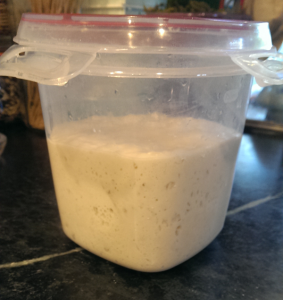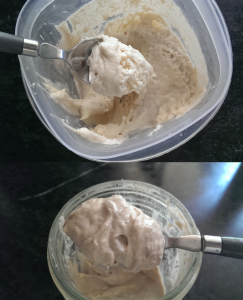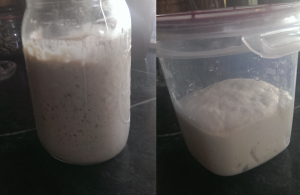It never fails to amaze me how a lot of home bakers, especially newbies, turn their sourdough starters into objects of obsessive-compulsive desire. Recently, in fact, I was bemused to read a sourdough neophyte’s post in which he mentioned, with as dead a pan as Grant Wood ever painted, that he was feeding his established sour twice a day. Twice a day!!! And people wonder why their breads don’t get sour enough.
Or how about the endless debates on which flour is best for feeding a yeast culture – as if those cute little eternally hungry fungi care where their next meal is coming from, or whether it’s the carb equivalent of filet mignon or pâte de Dumpster.
And another thing: sours localize. After about the fifth or sixth feeding, that authentic SanFran culture – Saccharomyces sanfransiscensis, for all you yeast nerds out there – that you shelled out big bucks for has been completely replaced by your local wild yeast, which you could have gotten for nothing simply by building a starter from scratch (of which more in another post).
I’ve always been of the opinion, and the facts bear me out (as you shall soon see) that those splendid wild yeasts and their lactobacillius symbiotes can take far rougher treatment than a lot of us give them credit for and still remain robust and ready to leaven at a moment’s – well, several hours’, actually – notice. After all, the airborne yeasts and bacteria in which we respirants swim have to survive not only warm weather, when naturally occurring carbs abound, but also the carb-famine cold months. Their survival is a testament to evolution and the vitality of the meanest and sourest.
As a case in point, take my sours (please!), one rye and one wheat, which I haven’t coddled, overfed, or even given cute names, as have some hardcore breadies. To me, they’re simply fungal-bacterial-enzymal ménages à trois, teeming with ever-ravenous microbes, that have found a home in my fridge. I feed them when I (a) want to bake sourdough, (b) remember to do so, or (c) when my conscience gets the best of me.
Nor do I agonize over their next meal. While I confess that my love of Jewish rye compels me to feed my rye sour with white rye flour only, I give my wheat sour whatever I have on hand, whether it’s first clear flour, bread flour, AP, or even (gasp!!!) cake flour. In fact, cake flour makes a pretty good nutrient for established sours, since it’s so rich in complex carbs (read = starches), which all those enzymes – maltase, amylase, diastase – will happily break down into the simple sugars that their yeasty roommates crave. The yeasts, in turn, throw off CO2 and alcohol, on which the lacto get high and return to the mix as lactic and acetic acid. The one thing I do pay attention to, though, is hydration, which I scrupulously maintain at 60% for the wheat and 80% for the rye.
A balanced and robust sour needs time to develop – not a huge amount; maybe a couple or three days. So to me, overfeeding not only is wasteful, it’s actually counterproductive. Rather, I want to give my microbial pals the chance to work their magic and send it around the food chain so that all of us can eat well, live long and prosper.
Refrigerating slows the process down, giving us an enormous amount of control over our sours. Those little yeasty beasties are busiest at 80°F to 100°F (27°C to 38°C), and go into near-idle mode at refrigerator temps of 38°F (3°C) or so. At those same temperatures, the lactobacilli also doze off, but remain active enough to produce small amounts of acid: the longer my starters sit in the fridge, the sourer they become.
So there it is: call me a fungus abuser if you will, but I’ve found that those little guys do just fine as long as I keep their environment cool and moist and throw them a carbo-bone every once in a while. In the meantime, they sit patiently by in my fridge, waiting to play their critical role in my next batch of sourdough; and if I take more time between bakes than other bakers, they never complain. A nice feeding, given a day or two before I mix my dough, resuscitates them and keeps them happy as mushrooms on a rotting log.
My sours are loyal retainers who’ve never failed me: perhaps I should give them names after all – something endearing, like Popeye and Olive, or maybe just Wheat and Rye.






Please explain why hydration is so important. When I see formulae that specify starters at specific hydrations I’m either put off trying them or simply use my regular ‘just too stiff to pour’ starter & adjust the texture of the resulting dough with water as needed. It always seems to work.
Just what is so crucial about the hydration of a starter that has Daniel Leader for example specify a different one for several of his formulae?
The degree of hydration affects lactobacillus viability: a wetter environment inhibits lacto activity and promotes the formation of acetic acid, so that the sour profile of the sour can vary between vinegar (acetic) and yogurt (lacto), depending on hydration.
Thanks for some reasonable words that mirror my experience. Keep it up!
I could hug you for your common sense approach, Stanley! Reading over and over again how people treat their starters like delicate celebrities in constant demand of attention, makes me succumb to the “rolling-eye-syndrome”.
I confess being a raven mother (as the Germans say) to my SDs, feeding them only when I bake, and almost used them up, or before longer trips abroad. They are kept in the fridge, perform admirably, and make great tasting breads.
Interesting, what you say about the hydration, I keep my WW-sourdough at 75% (recommended by Peter Reinhart) and my whole rye SD at 100% (as most German bakers do).
I’ll add a link to this post to my blog post on sourdough.
Karin
What a revelatory article this is, Stan. I have been feeling that you-know-what guilt for ignoring my starters (the same twain) for 3, 4 or even 5 days. I followed the discussion re. Hamelman’s rye class attended by a group of TFL’ers, and the mantra of “twice a day” began to haunt my dreams. When I baked my fave sourdough (pain au levain w/ two starters) after that rigorous feeding schedule and the result was a big flavor let-down, I panicked, thinking I had lost forever what I had achieved (good enough for a blue ribbon at the county Harvest Fair months earlier). Thank you, thank you for this commonsense article.
Joy
What always amazes me is how some people think they have THE answer. I’m happy to have A answer.
Jeff Hamelman, a world champion baker, says feed twice a day. He also only uses fresh yeast on yeasted breads, although other world champion bakers say active, instant and fresh yeast all produce the same results. When our demi-gods argue, whom are we to believe?
Gerard Rubaud, an awesome French baker living in America, feeds his starter 4 times a day. More info about Gerard Rubaud at http://www.farine-mc.com/2009/11/meet-baker-gerard-rubaud.html
Many German bakers get a fresh pure culture from a laboratory on Friday, use it to inoculate a thin rye flour/water mix and leave it in a temperature controlled vat with agitators. By Monday, it is very, very sour. They use that culture, without any refreshment all week long. The culture is very dead, so they get their rise from commercial bakers yeast added to the dough. And German bakers make some very good breads. According to Dr. Gänzle, younger German bakers are moving away from this and back to more classical sourdough techniques where they don’t over-sour their starter and don’t use additional yeast.
When I was an active member of the Bread Baker’s Guild of America mailing list, several times a year some baker would ask how he could avoid feeding his starter twice a day – it’s too much of a pain, and they’d expand that when they fed once a day, their starters weakened and died.. And again and again the answer was, when you feed less than twice a day, your starter will weaken and die. And, in truth, most of the once a day feeding advocates also continue to tell you that it’s no big deal if your starter dies, it’s easy to start a new one. They know lots of ways to start a starter. Most of the bakers who tried the once a day reported back that they had a new starter and were feeding it twice a day. People who kept a thick starter, 66% hydration or less, had better luck than the bakers who used thin starters, 166% hydration or more.
On my own web page I suggest two feedings a day at 100% hydration, largely because I want the beginners who frequent my page to have success, so my recommendations are quite conservative. I know there are other ways. As many other ways as there are bakers, and that the bakers have their reasons.
How you treat your starter should, in the end, be guided by the results you want. Super-sour German ryes? Mild French breads? Intermediate to quite sour American breads?
Again, referring to Dr. Gäezle, it is far from clear that local yeast will take over a culture at all, much less in 5 or 6 feedings. How you feed a starter, and what, do play a large role in it’s behavior and flavor. But it isn’t clear that is because you killed off the Lactobacillus SanFranciscus (to use the old name). Dr. Gänzle points out he has cultures in his lab that have remained unchanged for over 50 years.
Your post is a good read. I’m just not sure how much of it to treat as the one true gospel.
Interesting comments (which I have no reason not to post, btw; I welcome challenges because they force me to reconsider my POV and refine my arguments).
First, I’d observe that “THE answer” is a tricky concept to define, let alone defend, especially when dealing with (a) subjective areas like flavor, and (b) living organisms (people included), which have a disconcerting tendency to go their own way and trash preconceived notions in the process.
My intent in writing this post was simply to point out the obsessive nature of some bakers’ relationships with their starters, and to restore a sense of perspective. For me, as for many, many others, baking is a hobby, just like needlepoint, gardening and volunteering in community organizations. I believe that hobbies are about exploration and relaxation, not about finding oneself in a constant state of anxiety about whether one is “doing it right.”
Sadly, that’s a mindset I see all too often among hobbyist bakers, who fret incessantly that their sours, or formulas or finished breads don’t conform to those of Hamelman, Reinhart. Lahey, Forkish, Chad Robertson or any other baker of note; not that those guys don’t produce phenomenal breads and are dedicated teachers, which they are, it’s just that somehow I think we forget, in this media-driven age, that people have been baking for millennia using wild yeast cultures, and that most of the time, their actions were dictated by necessity rather than pursuit of perfection. We seek the unattainable (objective perfection in a subjective pursuit) at the price of belief in our own competence. Sorry, Virginia, there is no Holy Grail.
I also need to make the distinction between amateurs, who bake for pleasure, and professionals who, above all else, require consistency in their products. I submit that the multiple daily feedings approach (assuming stable fermentation temp) is one way that the pros can and do make their sours consistent by limiting the activity windows and levels of both the yeast and bacteria in the starter. With a consistent yeast product, it’s much easier to let the real chemistry take place in the bulk ferment and proof, thus producing bread that’s consistent from batch to batch. Not so we amateurs, who are free to experiment and bake as we please, without concern over whether our inconsistent results will affect our livelihoods.
Finally, I would point out that my own experience with not feeding for weeks on end, repeated over years, flies in the face of your assertions about the high mortality rates of yeast colonies fed less often than once or twice a day. Perhaps you and the others you quote live in areas where the indigenous yeasts simply aren’t as robust as those in Southern California (although my starter is built on a culture from the Bay area — a gift, not a purchase).
So to sum up, my post is hardly gospel truth, but simply, as advertised, “a curmudgeon’s take on sourdough starters and those who love them.” I don’t presume to have definitive answers to anything, these days, let alone the mysteries of life at the microscopic level. Of one thing, however, I am certain: hobbies are about discovering, learning, improving, and most of all having fun. Anxiety isn’t part of my equation.
.
Hi Stanley, I have a few things to say about neglecting starters.
Bakers who insist a starter reverts to the local cultures are often the ones who neglect their starters. A starter has to be healthy to fend off other microorganisms.
Yeast isn’t the only consideration in a starter, there are also bacteria. Bacteria don’t like to be kept at low temperature for long periods of time, that is why we have refrigeration, because bacteria thrive above 40F, but they die off under 40F.
Bacteria are a large component in obtaining desired characteristics in sourdough baking. Companies that produce yeast and other cultures in manufacturing don’t dare neglect their cultures for fear of the culture being contaminated by an undesirable organism. If you want optimum yeasts/bacteria/enzymes in your baking, you will want to care and feed your starter for optimum health, not minimum health. You can even neglect and feed yourself poorly and still live, but you won’t perform as well as if you were healthy and vigorous. I would imagine your starer is void of good bread baking bacteria.
So yes, your starter produces bread, because yeast can live in colder climes, but it probably lacks the bacteria that help unleash the full potential of the grain and with that,the depth of flavor that is possible. I challenge you to make a new starter and keep it fed and cared for… see where it takes you on your sourdough journey.
Interesting to follow this discussion. I think there is a difference, too, between requirements for German kind of mixed wheat/spelt/rye breads and French type lighter breads. If I want to bake one of Jan Hedh’s loaves, or a Tartine country bread, I follow their feeding regimen for several days.
But I don’t sell those breads, mine have to be a little less fussy. I mostly follow Peter Reinhart’s (Whole Grain Breads) principles, with mixed leavens, to have a reliable rising time. But, since I cold retard almost all my doughs, I need much less commercial yeast.
The worst, in my opinion, is to adopt a “holier-than-thou”-attitude, and condemning everybody who doesn’t strictly adhere to the tenets of your chosen bread baking pope.